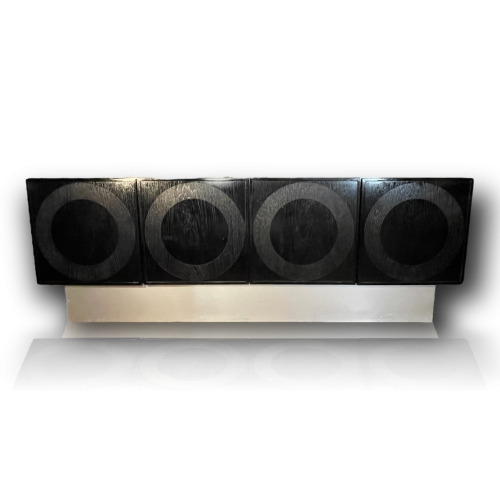Brutalist / Op'Art style buffet / sideboard with 4 doors, designed in the 1970s by the Belgian furniture company De Coene Frères in Kortrijk, this production is sometimes attributed to the Belgian designer Emile Veranneman.
Made of oak and sandblasted black lacquered oak forming an optical circle (typical of the Brutalist era of the 1970s).
Composed of 4 doors including a 2 drawer storage in one of the doors (see pictures) and shelves. The entire cabinet is set back on a base covered with a thick sheet of brushed aluminium.
In good condition, normal wear and tear due to time and use.
Inside dimensions of the two drawers: width 44,5cm, depth 35cm, height 10cm
- Period:20th Century / 1970s
- Place of Origin:Belgium
- Creator, Editor, Designer:De Coene Frères (Courtrai)
- Material:Sandblasted black lacquered oak, aluminium
- Weight:About 75 kg
- Dimensions (H x W x D):76,5 x 220 X 46 cm
- Condition:Good, normal wear and tear due to time and use
- Style:Modernism / Space Age / Brutalism / Op'Art
-
Price:4450€
- Belgium Delivery:Free
- International Delivery:On request
De Coene Frères (Kortrijk):
1887 is the year when the history of De Coene in Kortrijk begins. During the inter-war period, the company became internationally renowned for the production of high-quality Art Deco wooden furniture. Based on the Arts and Crafts philosophy, the company called on the services of great artists and architects, including the painter Albert Saverys. In addition to selling furniture individually to the wealthy bourgeoisie, the company was also responsible for custom furnishings for restaurants, hotels, casinos, trains, banks and other large institutions. Orders from abroad (France, the Netherlands and the United Kingdom) poured in and the company became one of the most important furniture manufacturers in Belgium and its reputation became international. From 1929 onwards, the company began to produce up to 1,000 radio cabinets per day for Philips Eindhoven. By the end of the 1930s, more than 3000 people were employed in the various departments. The company is still in business today...
